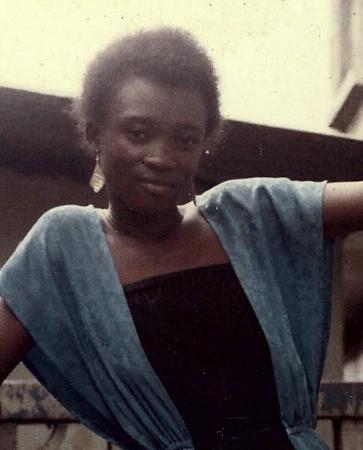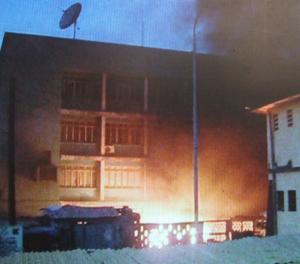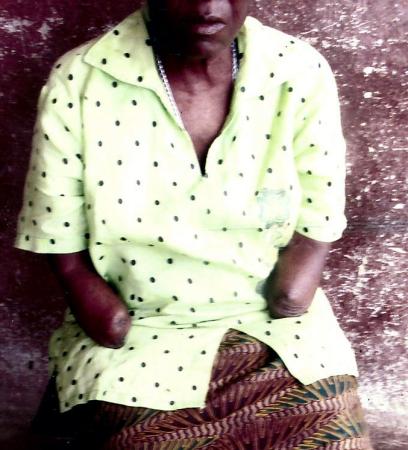Wednesday August 5, 2015 - As the bookkeeper of Auschwitz is sentenced we plead with the international community to bring to justice all those who deliberately slaughtered, raped and made sexual slaves of Sierra Leoneans in a deliberate policy that had the hallmarks of genocide. 
On one of our pages we brought you the story of a 93-year-old former member of a team that processed the victims of Nazi terror at the infamous Auschwitz concentration camp. Under a new law enacted by Germany, Oskar Groening was tried and convicted for being an accessory to the murders and terrible sufferings inflicted on human beings the Nazis chose to debase, dehumanise and exterminate. He did not personally take part in the executions, but he was a part of a system that started off with the processing of new inmates brought in at the concentration camp. He would note down the various possession stripped from the victims, hide their suitcases so that others coming in would not notice and ask questions about the large number of travelling containers that belonged to the victims. Oskar Groening did not take part in the gassing to death of prisoners nor did he take part in the many execution squads dotted all over the place but the law found that he was complicit in a process of extermination of human beings thought to be walking the wrong path as prescribed by the evil overlords of the Nazi regime. The bookkeeper of Auschwitz was found guilty by a court and sentenced to four years in prison for his part in the activities at the Auschwitz concentration camp. One BBC report on the court verdict states - Oskar Groening, known as the "book-keeper of Auschwitz", was sentenced to four years in prison. He was responsible for counting the belongings confiscated from prisoners and had admitted "moral guilt". His lawyers said he did not facilitate genocide, but prosecutors argued that he had helped the camp run smoothly. Many observers have questioned whether Groening will ultimately be sent to jail, given his advanced age. He is expected to be one of the last Nazis to face a courtroom. Many observers have questioned whether Groening will ultimately be sent to jail, given his advanced age. He is expected to be one of the last Nazis to face a courtroom. Oskar Groening joked with his lawyers as the court waited for the judge to arrive to deliver his verdict. Watching him carefully was a small elderly man with bright eyes. Leon Schwarzbaum was 22 when he was transported to Auschwitz. He told me he is now 94 - the same age as Groening. He pointed to the tattooed numbers on his arm. "When they punched this on my arm they told me no-one lasts long in Auschwitz." After the verdict, I saw him again; four years is the right sentence, he said, after all he's an old man. Can he forgive Oskar Groening, I asked? "No," he replied. "I lost 30 members of my family in Auschwitz." A statement from a group of Holocaust survivors and victims' relatives said the pain of losing families at Auschwitz could not be alleviated by criminal proceedings or the words of the accused. "But it gives us satisfaction that now the perpetrators cannot evade prosecution as long as they live," the statement said. The case revolved around the question of whether people who had played a minor role in the Nazi-ordered genocide but had not actively killed any Jews could still be guilty of a crime. Cornelius Nestler, a lawyer for a group of plaintiffs, said the case demonstrated that Auschwitz as a whole was "a murder machinery". "Everyone who participated in it has to take responsibility for it," he told Reuters news agency. Groening had publicly discussed his role at Auschwitz, making him unusual among former Nazis brought to trial. He said he was speaking out in order to silence those who deny the Holocaust took place. "I saw the gas chambers. I saw the crematoria," he told the BBC in the 2005 documentary Auschwitz: the Nazis and the "Final Solution". "I was on the ramp when the selections [for the gas chambers] took place." More than one million people, most of them European Jews, died between 1940 and 1945 in the Auschwitz-Birkenau camp in Nazi-occupied Poland. The Special Court for Sierra Leone has now almost wrapped up its operations but we are reminded of the formation of the Residual Special Court for Sierra Leone whose duties and other documents could be retrieved from its pages. The Residual Court would, say if Johnny Paul Koroma pop up suddenly swing into action and try the knave, killer and rapist whose band of like-minded individuals enslaved and visited awful horror upon horror on the people of Sierra Leone. This reminder should remind us of why it was necessary to set up the original Special Court for Sierra Leone - Negotiations between the United Nations and the Government of Sierra Leone on the structure of the court and its mandate, produced the world's first "hybrid" international criminal tribunal, mandated to try those "bearing the greatest responsibility" for crimes committed in Sierra Leone after 30 November 1996, the date of the failed Abidjan Peace Accord. It was the first modern international tribunal to sit in the country where the crimes took place, and the first to have an effective outreach programme on the ground. The Special Court Statute empowered the Prosecutor to bring charges for war crimes (violations of Article 3 common to the Geneva Conventions and of Additional Protocol II), crimes against humanity, other serious violations of international humanitarian law, and certain serious violations of Sierra Leonean law. Now for the key trials. In March 2003 the Prosecutor brought the first of 13 indictments against leaders of the Revolutionary United Front (RUF), the Armed Forces Revolutionary Council (AFRC), and the Civil Defence Forces (CDF), and then-Liberian President Charles Taylor. Two others died, one of them before proceedings could commence (RUF Leader Foday Sankoh) and one outside the jurisdiction of the Court (RUF Battlefield Commander Sam Bockarie). A third, (AFRC Chairman Johnny Paul Koroma), fled Sierra Leone shortly before he was indicted. While some evidence suggests that Koroma is dead, it is not considered conclusive and he is therefore officially considered to be at large. One person (Samuel Hinga Norman) died during the course of his trial, and proceedings against him were terminated. Nine persons were convicted and sentenced to terms of imprisonment ranging from 15 to 52 years. Sentences of the eight RUF, CDF and AFRC prisoners convicted in Freetown are being enforced at Rwanda's Mpanga Prison due to security concerns. Let us remind ourselves - "Nine persons were convicted and sentenced to terms of imprisonment ranging from 15 to 52 years. Sentences of the eight RUF, CDF and AFRC prisoners convicted in Freetown are being enforced at Rwanda's Mpanga Prison due to security concerns." It is no secret that the nine convicted persons were not the only ones involved in committing gross human rights violations against the people of Sierra Leone. They were on trial because they were deemed to carry the greatest responsibility. We are now therefore urging the international community to help put a closure to the suffering of Sierra Leoneans enslaved in their own God-given country by setting up a court that would try the foot soldiers, those on the ground who in some cases could have been involved in genocide as they killed all those they considered did not support them or belonged to the party of then President Ahmad Tejan Kabbah. Oskar Groening did not personally pull the trigger, nor start the switch that allowed the gases into the killing chambers. Nevertheless he was tried, convicted and sentenced to four years in jail despite his age and in reference to an event that happened some seventy years ago. In Sierra Leone those who carried out the rapes, abductions, murders of innocent civilians still walk the alleyways and byways of the country, protected by a rat of a President whose hand in the support for the killing machines of the AFRC/RUF should be the subject of an investigation. We would again want to remind you of one Leatherboot or Idrissa Kamara who now enjoys the protection of the rat at State House and whose exploits is documented on the pages of the report into the attack on the headquarters of the main opposition Sierra Leone Peoples Party headquarters in March 2009. Leatherboot was also implicated in the murder, rape and abduction and enslavement of students during the August 18, 1997 AFRC/RUF crackdown on students who wanted the illegal regime of Johnny Paul Koroma out of power. There are survivors who can testify against this operative of the murderous junta and who is now a part of the security detail (enforcer) of State House. We believe that the testimonies of those who were on trial as well as the accounts of witnesses should form the basis for the preliminary investigations and eventual trial of all those who actually carried out gross human rights violations and crimes of war against unprotected, vulnerable and innocent civilians and no stone should be left unturned in bringing these murderers and rapists to justice. The Special Court for Sierra Leone has done its bit under its limited mandate but it is left to the international community to ensure that impunity is never allowed to go unpunished. Justice for the victims should be our watchword in bringing the much-needed proper closure to the dark past in Sierra Leone. Here's an account from one witness on the decision to slaughter more than two hundred civilians - unarmed civilians who were fleeing from danger and wanted to cross the border into neighbouring Guinea. "So the civilians were now at the border when Isaac got the information - when he was leaving Koindu to come back to Kailahun he got the information and he went to the border with his bodyguards and the civilians were there, men, women, children, pregnant women. They said the people are up to 200 and Isaac Mongor killed all of them. He killed each and every one of them. So the people were - he said they were now enemies because they were trying to escape to Guinea, so he decided to execute all of them." And here's this on the murderous actions of a megalomaniac called Foday Sankoh. "The fall of Pendembu to the government forces in May 1993 was viewed by Corporal Sankoh as a plot by a group of people who had incited his combatants against him. Corporal Sankoh became engulfed by fear and paranoia, decided to divert the attention of the combatants from the main reason for the massive retreats. He therefore directed his political machinations to one of his concubines called Jande Goba. It was alleged that Jande, her sister Abie Aruna, the brother, Ansu Nemahun and many others of Luawa Giehun in the Kailahun District had collaborated with Mr Siafa (OC Siafa) so that the government forces could overrun Kailahun District. In pursuance of this plot, it was alleged that Mr Siafa crossed from Guinea to Mafindor in Kailahun where the plot was hatched. To try the alleged coup plotters, Sankoh set up a jungle court and a slaughter machine at Giehun under the command of the chief judges/executioners in the persons of Sam Bockarie (Mosquito) and Issa Hassan Raka Sesay. In this Court, people were summarily executed on very flimsy evidences. It is conservatively estimated that about 200 people, both civilians and combatants, were murdered in cold blood. Once it was proved that somebody hailed from Luawa Giehun, the person was automatically pronounced guilty and then tortured and executed. Jande Goba was murdered in the most gruesome manner. Her hands were tied behind her back and steaming oil poured on her pubic area." This is a well-planned pogrom for which there must be justice for the victims and we call on the international community/the ICC to see that justice is done and that impunity is not allowed lest others of a similar disposition take it in their heads that it was legitimate to carry out such massive human rights violations against civilians. Kindly note the crimes of war and genocide committed in these two cases. 1. "Once it was proved that somebody hailed from Luawa Giehun, the person was automatically pronounced guilty and then tortured and executed." 2. "Gullit ordered further attacks on civilians because he said these had betrayed them by welcoming ECOMOG soldiers. Sesay said he went with one group to Ferry Junction, where they shot everyone in a market, pulled people from their homes to kill them with guns and machetes, and burned others alive together with their houses." Those who wielded the machetes, pulled the triggers, poured the fuel on houses to be torched are still alive and are recognised by their surviving victims as they are given cosy lives by the government of the rat at State House. These are some accounts of atrocities as found on the pages of the Sierra Leone Peace Museum.
|




